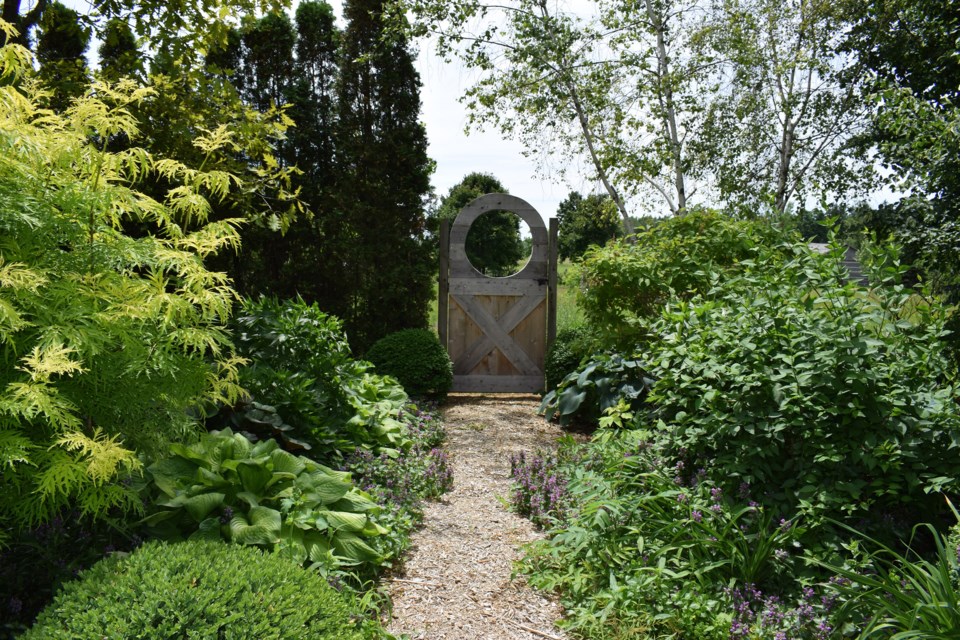When it comes to garden design, we would never lead you “down the garden path”. At least, not in the sense of going astray.
However, we often ignore the very paths that lead us through our garden. That is, until all else is planted. A garden path that functions at its very best is an integral part of a garden scheme.
Fall is an excellent time of year to plant and, by extension; it is a wonderful time of year to consider where your paths lead.
Why a path at all?
The path not only provides a guide for your feet, it also leads your eyes. Truth is, you will likely look down a path many more times than you will walk it.
Where does your path lead your eyes? There are two primary goals in creating a path: to lead the eye to a destination, or to lead around a corner. Either way, you are enticing visitors to move through the garden.
Destination
Nothing moves people down a path like a place to sit. A park bench or permanent, comfortable garden chair at the end of a path pulls the visitor through the garden, with a reward at the end.
Many other garden features can motivate people to move down a path. A water feature, especially one accompanied by the sound of moving water, works like magic. A large piece of art or statuary can be powerful motivators too.
Mystery
If you choose to hide the destination around a corner, make sure that the path is sufficiently wide to make the trip tempting and easy to navigate. Changing the colour of foliage at the corner can help to create some intrigue about what is out of sight. Choose a variegated hosta or series of plum coloured Coral Bells (heuchera). A bird feeder or bird bath can work too.
What is it made of?
The material that you use to create a path is as important as where it goes.
A layer of pea gravel announces the visitor’s arrival with a crunch. Not a bad idea when there is a skunk lurking around the corner. The sound of feet on gravel reminds us of where we are (a garden) and where we are not (an asphalt road).
Patio slabs are making a come-back. They are generally framed in gravel or fine bark mulch and the path itself bordered by stone sets or bricks half-buried on either side of the path. Framing concrete slabs in this way takes your attention away from the slabs and settles your eye on the landscape. Kind of like using an expensive steak sauce on an otherwise pedestrian steak.
Flag stone is making a come back also. Random flag stone looks great with creeping thyme or Irish moss growing between the slabs. Place quality soil at least four centimetres deep before squishing the plants, roots and all, between the stones.
Square cut flag stone works well with fine bark mulch settled between the slabs. Avoid using mortar between them. This works well in Britain and Florida, where long, deep ground frost is not an issue. But here in Canada, the cement mix always heaves and cracks over time. The extra expense of mortaring the stones always leads to disappointment.
Grass can be a path. Many gardens are so intensely planted with trees, shrubs and flowers that a narrow strip of grass becomes a break and an invitation to walk through the garden. There is virtually nothing as cool as walking on green grass bare foot (or not) and it is generally easy to maintain.
Go Home.
The one cardinal rule of paths is this: it should always lead you home. The idea of taking a walk through your own garden is one of adventure: what is flowering today? Are there any interesting bugs? What birds might you see? The more walking through gardens we do, the more sensitized we become to the green world around us. This is the real world and the path will bring you home from this escape to reality.
Mark Cullen is an expert gardener, author, broadcaster, tree advocate and Member of the Order of Canada. His son Ben is a fourth-generation urban gardener and graduate of University of Guelph and Dalhousie University in Halifax. Follow them at markcullen.com, @markcullengardening, on Facebook and bi-weekly on Global TV’s National Morning Show.



